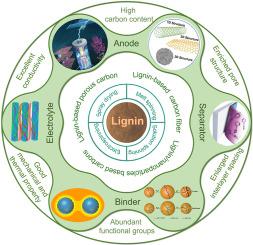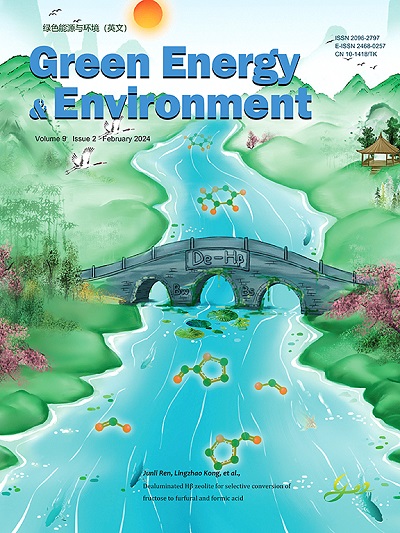锂离子/钠离子电池中木质素衍生材料的研究进展
IF 14.6
1区 工程技术
Q1 CHEMISTRY, PHYSICAL
引用次数: 0
摘要
随着能源消耗的增加、化石资源的短缺和环境污染的加剧,开发经济、环保的生物基储能装置已成为当务之急。木质素是自然界中含量第二丰富的天然聚合物,主要产生于造纸制浆和生物精炼工业。木质素具有成本低、含碳量高、官能团丰富、生物可再生等固有优势,是一种极具吸引力的充电电池材料。因此,利用木质素或木质素基碳材料作为锂离子电池(LIBs)或钠离子电池(SIBs)的电极、粘结剂、隔膜和电解液等部件的研究兴趣日益高涨。本综述全面概述了木质素衍生材料用于锂离子电池/钠离子电池的研究进展,尤其是木质素基碳作为锂离子电池/钠离子电池阳极的应用。系统地讨论了不同维度木质素衍生材料的制备方法和性能,重点探讨了木质素衍生材料的化学/物理结构与 LIBs/SIBs 性能之间的关系。此外,还提出了木质素衍生材料在储能设备中的当前挑战和未来前景。本文章由计算机程序翻译,如有差异,请以英文原文为准。

Research progress of lignin-derived materials in lithium/sodium ion batteries
With the increase of energy consumption, the shortage of fossil resource, and the aggravation of environmental pollution, the development of cost-effective and environmental friendly bio-based energy storage devices has become an urgent need. As the second most abundant natural polymer found in nature, lignin is mainly produced as the by-product of paper pulping and bio-refining industries. It possesses several inherent advantages, such as low-cost, high carbon content, abundant functional groups, and bio-renewable, making it an attractive candidate for the rechargeable battery material. Consequently, there has been a surge of research interest in utilizing lignin or lignin-based carbon materials as the components of lithium-ion (LIBs) or sodium-ion batteries (SIBs), including the electrode, binder, separator, and electrolyte. This review provides a comprehensive overview on the research progress of lignin-derived materials used in LIBs/SIBs, especially the application of lignin-based carbons as the anodes of LIBs/SIBs. The preparation methods and properties of lignin-derived materials with different dimensions are systemically discussed, which emphasizes on the relationship between the chemical/physical structures of lignin-derived materials and the performances of LIBs/SIBs. The current challenges and future prospects of lignin-derived materials in energy storage devices are also proposed.
求助全文
通过发布文献求助,成功后即可免费获取论文全文。
去求助
来源期刊

Green Energy & Environment
Energy-Renewable Energy, Sustainability and the Environment
CiteScore
16.80
自引率
3.80%
发文量
332
审稿时长
12 days
期刊介绍:
Green Energy & Environment (GEE) is an internationally recognized journal that undergoes a rigorous peer-review process. It focuses on interdisciplinary research related to green energy and the environment, covering a wide range of topics including biofuel and bioenergy, energy storage and networks, catalysis for sustainable processes, and materials for energy and the environment. GEE has a broad scope and encourages the submission of original and innovative research in both fundamental and engineering fields. Additionally, GEE serves as a platform for discussions, summaries, reviews, and previews of the impact of green energy on the eco-environment.
 求助内容:
求助内容: 应助结果提醒方式:
应助结果提醒方式:


